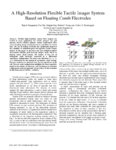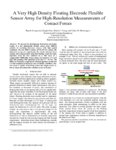1 - 25 of 14
Number of results to display per page
| Creator | Title | Description | Subject | Date | ||
|---|---|---|---|---|---|---|
| 1 |  | Harrison, Reid R. | Mobile robot navigation in enclosed large-scale space | In a large-scale s ace, navigation may occur among very dispersed landmarks, further apart than the range of sensing of an autonomous vehicle. In this work we investigate the feasibility of construction of a landmark-based cognitive map, whose elements are the obstacles perceived by a robotic vehicl... | 1994-01-01 | |
| 2 |  | Harrison, Reid R. | Eyes and ears: combining sensory motor systems modelled on insect physiology | Integrating sensorimotor systems is still a difficult problems for robotics. Biological inspiration, which has been effectively used to address single sensorimotor tasks, could also be applied to this problem. Several studies on the cricket suggest that it integrates an optomotor response to two exi... | 2000-01-01 | |
| 3 |  | Harrison, Reid R. | Integrating sensorimotor systems in a robot model of cricket behavior | The mechanisms by which animals manage sensorimotor integration and coordination of different behaviors can be investigated in robot models. In previous work the first author has built a robot that localizes sound based on close modeling of the auditory and neural system in the cricket. It is known ... | 2000 | |
| 4 |  | Harrison, Reid R. | Phonotaxis in crickets and robots | Over the past decade, we have built and tested several robot models to investigate a particular biological behavior, the sound localizing (phonotaxis) ability of the cricket. This work has had several purposes. One is to develop robotic technology, such as novel sensors and control systems, by copyi... | Phonotaxis | 2002 |
| 5 |  | Mastrangelo, Carlos H. | A high-resolution flexible tactile imager system based on floating comb electrodes | Flexible high-resolution contact force imagers are needed in many applications for robotic grippers and gait analysis, but its intrinsic intimate contact requirement often causes breaking of top metallization layers and failure in a short time. The use of floating electrodes has significantly improv... | 2012-01-01 | |
| 6 |  | Mastrangelo, Carlos H. | A very high density floating electrode flexible sensor array for high-resolution measurements of contact forces | We present the development, fabrication and testing results of a new high-density flexible sensor array (HDFA) suitable of recording three-axis stresses with high spatial resolution. The new HDFA consists of 676 (26×26) sensing cells fabricated on top of a high-density flex circuit substrate. Each ... | 2013-01-01 | |
| 7 |  | Stevens, Kenneth | Fractional-order signal processing using a polymer-electrolyte transistor | Fractional-order systems have applications in the areas of Flight Control, Robotics, Missile Guidance, Control of Structural Vibrations of Space Platforms and Sensor Technology. Fractional-order transfer functions can characterize complex nonlinear dynamics with many fewer parameters than integer-or... | 2008 | |
| 8 |  | Furse, Cynthia M. | New IEEE AP-S education web site: course/lab notes, scholarships, K-12 outreach | Greetings from the Snowy West! This month I am pleased to announce a new effort on the part of the IEEE Antennas and Propagation Society Education Committee to collect course and laboratory links relevant to the AP-S community, and compile them in a central location where they can be easily accessed... | IEEE AP-S; Education web site; Course notes; Lab notes; K-12 outreach | 2004 |
| 9 |  | Mastrangelo, Carlos H.; Young, Darrin J. | Personal navigation via high-resolution gait-corrected inertial measurement units | Abstract-In this paper, a personal micronavigation system that uses high-resolution gait-corrected inertial measurement units is presented. The goal of this paper is to develop a navigation system that uses secondary inertial variables, such as velocity, to enable long-term precise navigation in th... | 2010 | |
| 10 |  | Harrison, Reid R. | Sweep strategies for a sensory-driven, behavior-based vacuum cleaning agent | In the Machine Intelligence Laboratory, University of Florida, we have built a small autonomous robot and programmietd to exhibit various reactive behaviors.T he robot, namedG ator,p erformsa rea coveragein an interior room by combining distinct behaviors. Gator has 26 sensors of which only 7 are... | Sweeping behavior; Claustrophobia | 1993-01-01 |
| 11 |  | Harrison, Reid R. | Design and implementation of multipattern generators in analog VLSI | In recent years, computational biologists have shown through simulation that small neural networks with fixed connectivity are capable of producing multiple output rhythms in response to transient inputs. It is believed that such networks may play a key role in certain biological behaviors such as d... | 2006-07 | |
| 12 |  | Harrison, Reid R. | Low-power analog VLSI visual collision detector | We have designed and tested a single-chip analog VLSI sensor that detects imminent collisions by measuring radially expansive optic flow. The design of the chip is based on a model proposed to explain leg-extension behavior in flies during landing approaches. A new elementary motion detector (EMD) c... | VLSI; Visual collision detection; Elementary motion detectors | 2004-01-01 |
| 13 |  | Harrison, Reid R. | Fly-inspired VLSI vision sensors | Engineers have long looked to nature for inspiration. The diversity of life produced by five billion years of evolution provides countless existence proofs of organic machines with abilities that far surpass those of our own relatively crude automata. We have learned how to harness large amounts of ... | 2002 | |
| 14 |  | Harrison, Reid R. | Biologically inspired analog IC for visual collision detection | We have designed and tested a single-chip analog VLSI sensor that detects imminent collisions by measuring radially expanding optic flow. The design of the chip is based on a model proposed to explain leg-extension behavior in flies during landing approaches. We evaluated a detailed version of thi... | Visual collision detection; VLSI | 2005-11 |
1 - 25 of 14
